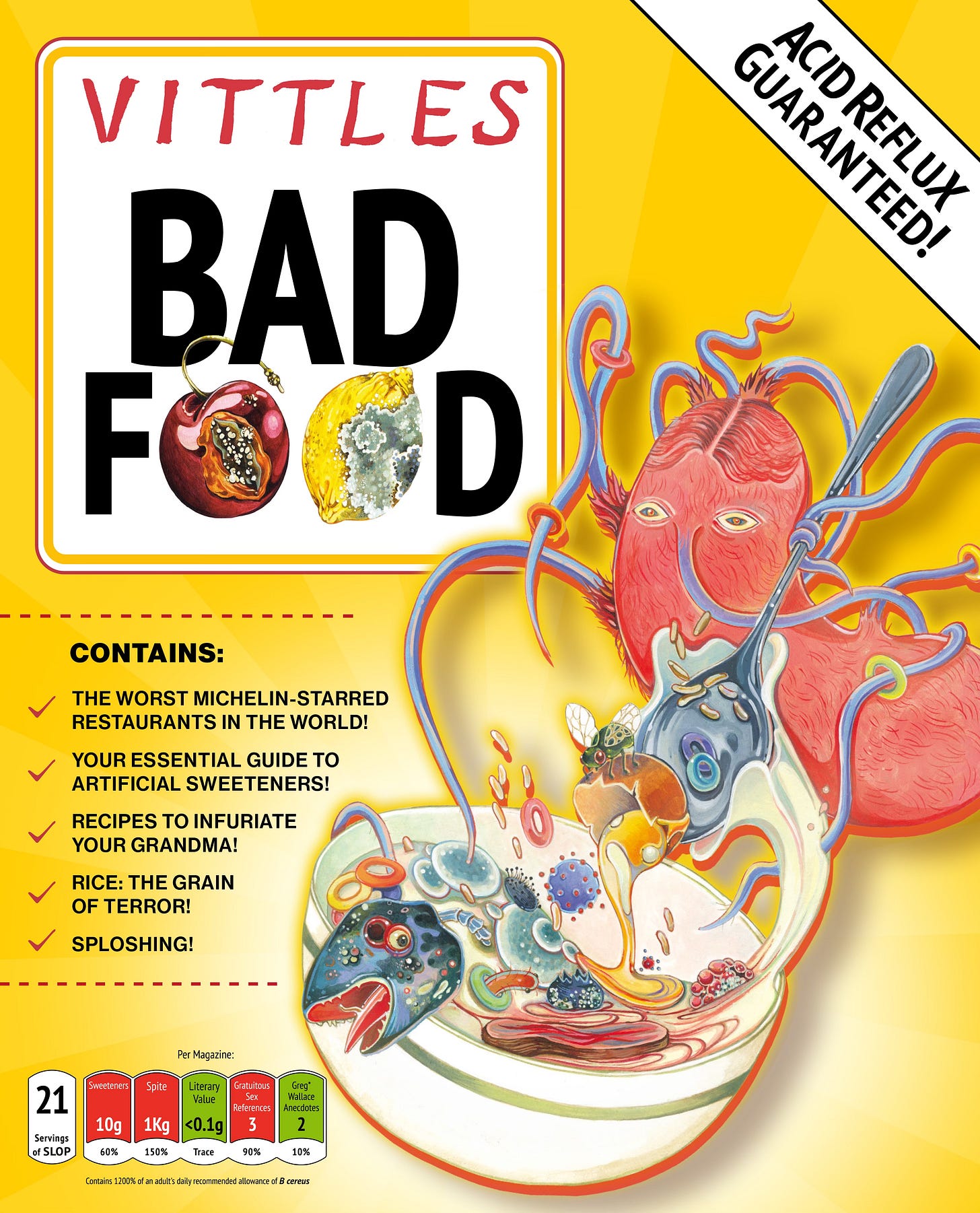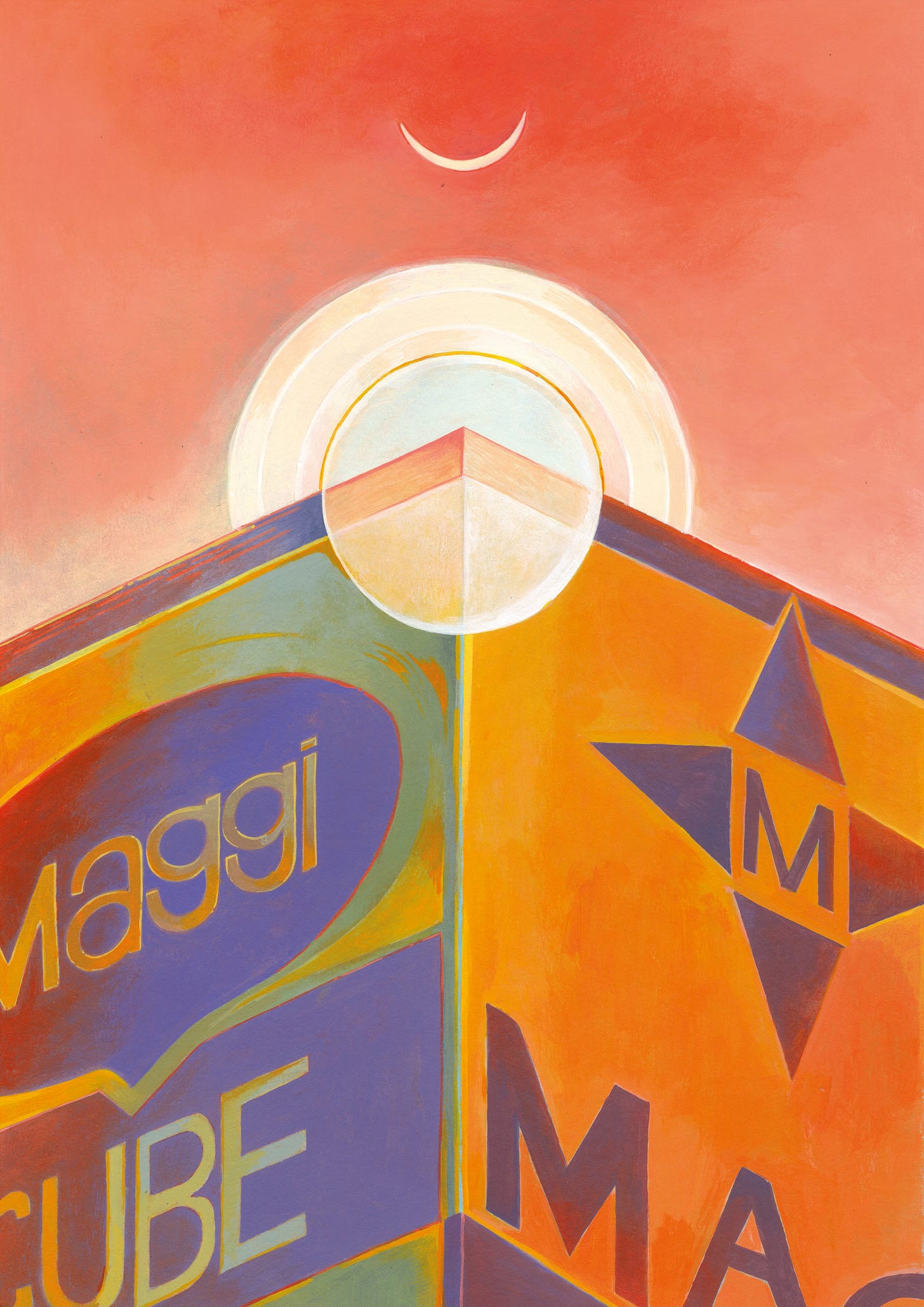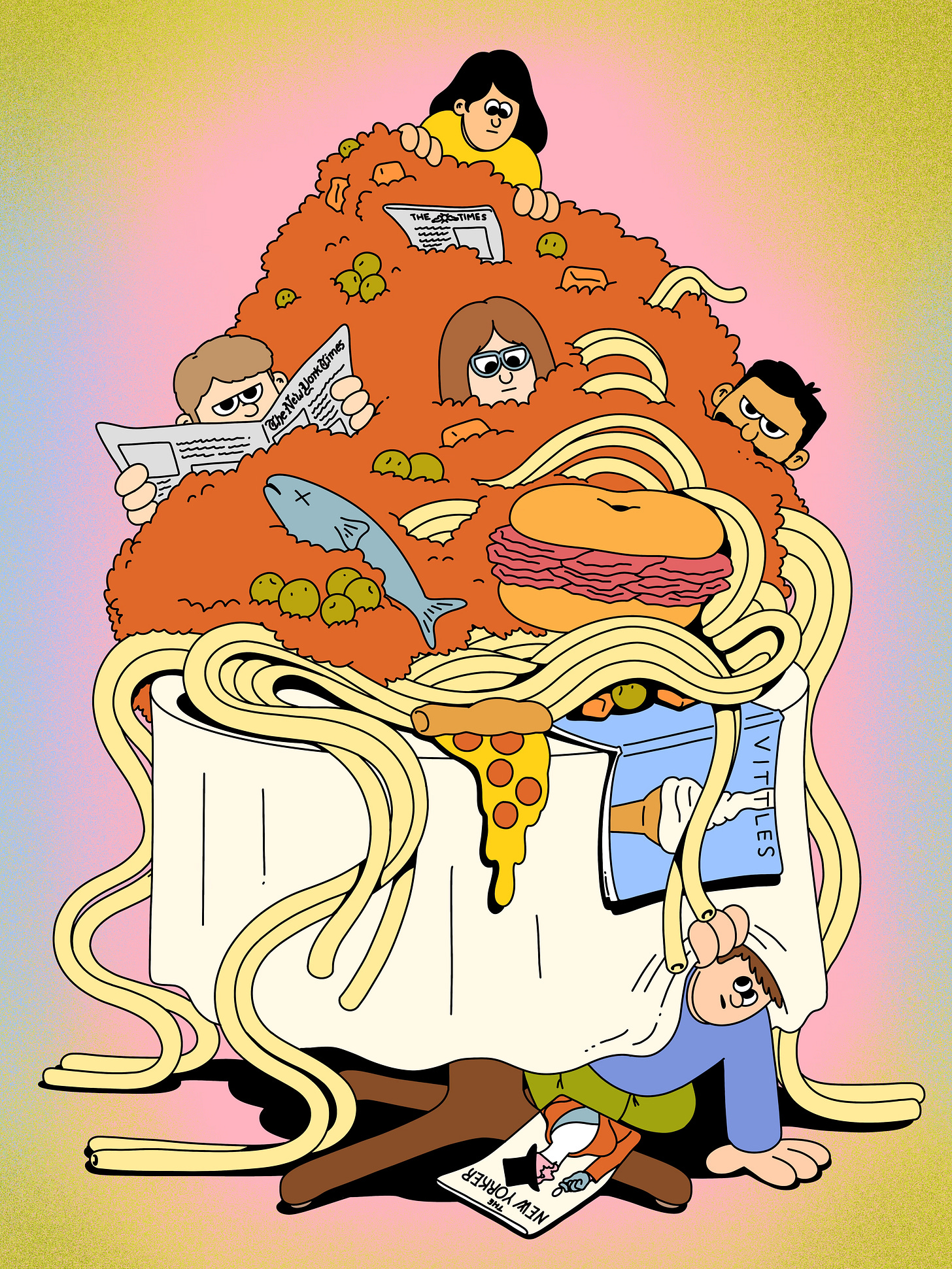Vittles Issue 2: Bad Food
A magazine about modern terrible food and culture
With the talented contributions of:
Joe Zadeh, Tania Sanchez, Munir Hachemi, Johanna Hedva, Rukmini Iyer, Sheena Patel,
Pete Wells, Helen Rosner, Chitra Ramaswamy, Andy Ho, Joyeta Ng, Joké Bakare, Ozoz Sokoh, Sharanya Deepak, Lily Kelting, Amel Mukhtar, Melek Erdal, Lauren J Joseph,
Morgan M Page, Ms Pistachio Paradise, Chris Jones, Alim Kheraj, Andy Hayler,
Adam Coghlan, Niloufar Haidari, Kelly Pochyba, Saira Banu, Emefa Ansah, Joel Golby,
Karl McDonald, Matthew Bye, Simran Hans, Zarina Muhammad, Fiona Hyde, Feroz Gajia, Rahel Stephanie, Ixta Belfrage, Jonathan Nunn, Sing Yun Lee, Sinae Park, Kenneth Lam,
Lou Kiss, James Clapham, Ibrahim Rayintakath, Svabhu Kohli, Ben McMahon, Ula Zuhra, Azra Sadr, Georgia Rudd, Wunmi Onibudo, Julia Sanches, Ella Bucknall, Peter McAteer,
Jules Scheele, Beatrice Barr, Joy Yamusangie, Lauren Martin, Alex Brenchley,
Lorenzo D’Alessandro, Olivia Sterling and Hannah Ekuwa Buckman.
Vittles: Issue 2 will be published in December 2025. Pre-order here.
This magazine began as a modest project about awful food and quickly spiralled out of control.
About a year ago, my colleague Sharanya Deepak mentioned that she was tired of South Asian food writing that was only about grandmas, who all seemed to be amazing cooks. This well-meaning food writing trope – in which a whole culture must be introduced to a readership through its tradition or sense of hospitality – had to die. Sharanya’s idea was an online supplement that ignored the virtuous aspects of cuisine and instead focused on the havoc that is regularly wreaked across South Asia in the name of food: pink sauce pasta, Szechwan sauce, the alliance of capital and stupidity that leads to a Jamie’s Italian in Delhi, or Chicken Cottages across Pakistan-administered Kashmir. In short: the exact opposite of nourishing grandma food. Eventually we got so invested in the idea of ‘bad food’ that we lost the South Asia focus and it became this magazine: 150+ pages of slop dedicated to terrible food in all its guises.
We’ve loved working on this issue. In a strange way, concentrating specifically on badness has been freeing. So much of food media – us very much included – is dedicated to finding goodness in food, whether it’s a recipe that works, a particularly well-made supermarket item or a great restaurant. Yet most foods sold commercially across the world don’t fit neatly into these categories. They might be indifferently cooked, or don’t fit with elitist notions of ‘good taste’. Or they might be just plain bad for you. These are the foods we wanted to re-evaluate and celebrate, and they have informed the sections we have divided this magazine into: Bad Cooking, Bad Taste and Bad Foods – a trifecta of badness.
Bad Foods is all about the things that are, or that are believed to be, bad for us. In an investigation we’ve long wanted to read, Joe Zadeh looks at the phenomenon of ‘fried rice syndrome’ and why so many white people fervently believe that you cannot reheat rice. Tania Sanchez, co-author of the legendary Perfumes: The A–Z Guide, turns her hand to writing about soft drinks, and the various sweeteners they contain. Morgan M Page writes movingly about the links between rotting food and transition. Chefs Joyeta Ng and Andy Ho have a frank discussion about the contemporary reappraisal of MSG and the difference in attitudes between people in Hong Kong and the diaspora in the West, while Ozoz Sokoh and Joké Bakare discuss the MSG-laden Maggi, and whether it has improved or ruined Nigerian cuisine. Additionally ten of our favourite writers choose their most compellingly evil supermarket items, from Charlie Bigham’s Lasagne and Yazoo milkshakes to ready-to-eat poached eggs.
Bad Taste was the genesis of this magazine, and begins with two long dispatches on ridiculous food in South Asia. The first is Sharanya Deepak’s epic on Italian food in India and Pakistan, which takes in alfredo fettuccine, keema noodles, pink sauce pasta and Balochi tikka lasagne – dishes that thrive despite puritanical Italian rage. The second, by Lily Kelting, is on the supremacy of Szechwan sauce, the beloved red condiment that fuels much of India’s street food but literally no one wants to take credit for. On the subject of bad manners, Amel Mukhtar and Melek Erdal navigate the classist and colonial connotations of table etiquette and eating with hands. Elsewhere, two contributions explore over- and under-restraint: legendary queer polymath Johanna Hedva writes about Simone Weil and her relationship with anorexia, while in an anonymous essay Ms Pistachio Paradise reveals what it’s like to combine sex work with food in the form of sploshing.
Finally, Bad Cooking is all about the restaurants, cafes and cooks that have given us the gift of bad food. Chris Jones of the essential 56a Infoshop in Elephant and Castle has written the history of the squat cafes that kept a swathe of London fed on skipped vegetables and international squat slop at the tail end of the millennium. Alim Kheraj discusses the tragic food in gay bars across the UK, from dry pork baps at Dempseys in Sheffield to buffets at gay saunas in the Docklands. In our roundtable, restaurant critics from both sides of the pond – Pete Wells, Helen Rosner, Chitra Ramaswamy and me – talk about how we evaluate bad food and restaurants, and the process of writing bad reviews. As an extra treat, we also chat with the Michelin Man himself, Andy Hayler, about whether Michelin is responsible for making food worse. On the cooking side of things, Rukmini Iyer answers all your burning questions about the British TV show MasterChef, its cooking legacy and her run-ins with its notorious judges, while we asked chefs Feroz Gajia, Ixta Belfrage and Rahel Stephanie to come up with a trio of disrespectful recipes that could potentially get them in trouble with their elders.
We’re delighted to include three stellar pieces of fiction, with short stories from Munir Hachemi (translated by Julia Sanches), Sheena Patel and Lauren J Joseph that veer between hunger, horror and horniness. Also, from now until publication day, we will be posting some online-only content related to the subject of Bad Food by various writers and contributors, including Aaron Timms, Vitória Croda, Mariam Abdel-Razek and more. See this as the magazine’s extended universe.
As with Issue 1, Bad Food has been a huge collective effort. It was put together by our editorial team, comprising Adam and Sharanya along with Rebecca May Johnson and Odhran O’Donoghue. We’ve been lucky to work with a wealth of illustrators and photographers, including some dream collaborations with Lauren Martin, Joy Yamusangie, Kenneth Lam and Ibrahim Rayintakath, which has made this magazine the most visually fun project we’ve ever worked on. Dan Biddulph designed a completely new magazine from scratch, along with our cereal box cover (an unintentional rip-off of hat-tip to Heston Blumenthal and Lucky Peach) with Sing Yun Lee. Sophie Whitehead sub-edited the whole thing and we even have a Bad Foods crossword by Beatrice Barr!
In many ways, Bad Food feels like our first issue. It is the first magazine we have commissioned entirely as a whole item and feels very much like us: a reflection of our love for the more absurd, stupid and evil parts of food culture. If you’re interested in mould, Maggi, monosodium glutamate, aspartame, Ace K, Irn Bru, dupe sodas, Richmond Sausages, Rustlers Burgers, Charlie Bigham, Red 40, E numbers, E coli, the oeuvres of Pierre Bourdieu, Simone Weil and Gregg Wallace, Sosmix, post-orgy roast dinner buffets, sploshing, squat slop, creamy cheese szechwan dosas, Massimo Bottura, Massimo Dutti and the worst three-star restaurants in the world, then this issue is for you.
Pre-order!!!! Now!
Like with Issue 1 (now sold out), this magazine is entirely self-published and funded only through user subscriptions. We have taken on no additional investment, and it contains no adverts. Pre-orders are vital for us. If you pre-order the magazine by 1 December the magazine will cost £18, down from the RRP of £20. Paid subscribers will get a further reduction to £16 – there’s a discount code after the paywall.
If you are a retailer and wish to stock Issue 2, then please email our distributor Antenne Books at maxine@antennebooks.com or mia@antennebooks.com.






